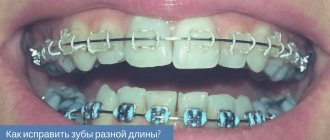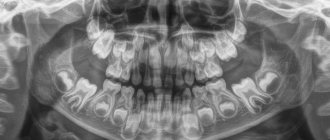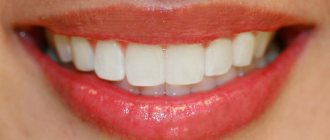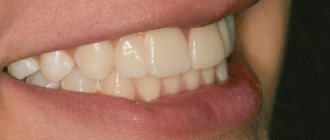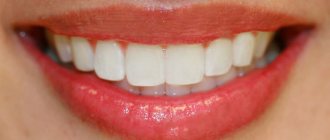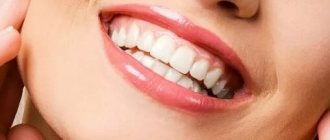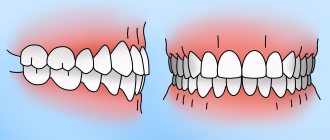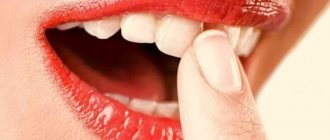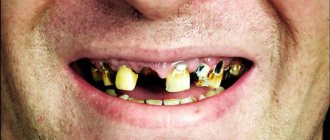21.11.2019
Children's baby teeth fall out and are replaced by permanent teeth. In rare cases, the first ones do not have time to fall out, but the second ones already grow nearby. This phenomenon received a specific name – “shark teeth”. Parents are always concerned about the question of what to do in such a situation.
Pathology mainly appears during the eruption of the lower central incisors. Less commonly, this happens with the growth of the upper incisors or molars.
Causes
A child's first teeth erupt in a certain order, starting at about six months of age. There are deviations in one direction or another, which is due to a number of factors (climate, drinking water) and the individual characteristics of the baby. For some, they appear as early as 1.5 months, for others - closer to a year. They fall out in the same sequence and are replaced with permanent ones. Complete replacement of the dentition occurs on average at the age of 12-13 years.
But there are also situations when permanent teeth begin to grow right next to the second row of milk teeth. If they are located in parallel, then this is called “shark teeth”. The name was coined by analogy with the anatomical feature of sharks. These predators have teeth arranged in three rows.
Possible reasons:
- genetics;
- improper formation of tooth germs during intrauterine development;
- rickets;
- infectious diseases (sinusitis, tonsillitis, adenoiditis).
Possible consequences
The appearance of the second row leads to serious negative consequences for the oral cavity and dentofacial apparatus. Among them:
- violation of diction;
- poor chewing of food with subsequent indigestion;
- curvature of the roots of neighboring elements, their displacement from their “rightful” place;
- change in bite;
- formation of trema and diastemas.
What devices are used to prevent malocclusion in modern orthodontics.
In this publication, we will look at the main signs of Costen syndrome.
Here https://orto-info.ru/zubocheliustnye-anomalii/okklyuzii/vliyaet-li-soska-na-prikus.html we’ll figure out whether the pacifier affects the child’s bite.
Why is it dangerous?
Despite the unattractive appearance of such a smile, there is no need to worry. Most often, dentists advise not to take any action. The root of the baby tooth softens, and the tooth falls out on its own after a certain period of time. The child facilitates this by loosening the tooth with his tongue or hands.
Despite the unattractive appearance of such a smile, there is no need to worry. Most often, dentists advise not to take any action. The root of the baby tooth softens, and the tooth falls out on its own after a certain period of time. The child facilitates this by loosening the tooth with his tongue or hands.
In what cases should you consult a doctor?
If the process is accompanied by unpleasant sensations and the child constantly complains, then you should not delay a visit to a specialist. It is recommended to consult a doctor in the following cases:
- The baby tooth does not fall out within three months after the permanent one appears;
- an inflammatory process develops;
- The baby tooth is very loose, causing anxiety and discomfort to the child.
The importance of proper breathing
Nasal breathing helps the jaws develop anatomically correctly. If you breathe through your mouth, there is a high risk of their underdevelopment. This fact can easily be explained by the fact that the tongue plays an important role in the formation of the jaws. In the first case, he takes the desired position. In the second case, the tongue is located at the bottom of the oral cavity and practically does not come into contact with the elements of the jaw arches. They do not develop properly and there is not enough space for permanent teeth.
The parents' job is to closely monitor their child's breathing. If nasal breathing is impaired during colds, a quick solution to the problem is required.
Concomitant pathologies
As already noted, the appearance of an anomaly is caused by a violation of embryogenesis and/or development of the child’s dental apparatus after birth.
The human body generates two types of teeth – primary and permanent. The first, 20 pieces, function from 2 to 6 years. Their replacement with permanent elements occurs in the period from 6 to 13-14 years.
By one year, the crowns of the “milk jugs” complete their formation and stop growing. The continued development of the jaws leads to the appearance of interdental spaces - diastemas and three.
The phenomenon does not relate to pathology, and disappears during the period of completion of the formation of the permanent occlusion. If a child aged 2-6 years does not develop interdental gaps, this indicates an abnormality in the development of the jaws.
The change occurs as a result of a certain biochemical process - resorption. The resorbing system, consisting of lymphocytes, osteoclasts and connective tissue, takes part in the resorption of “milk jugs”. The main role is played by osteoclasts - destructive cells that dissolve bone tissue.
At the beginning, the partitions between the roots of milk teeth and the rudiments of permanent teeth dissolve. Then the destruction of their roots begins in the area of contact with the coronal part of the growing permanent units. As the roots reabsorb, baby teeth become increasingly mobile and eventually fall out.
If the permanent tooth germ is located not under the milk tooth, but with a displacement to the side, the resorption process is disrupted. The “milk jug” maintains a strong connection with the alveolar process, preventing the growth of permanent teeth. And he has no choice but to grow up in the wrong place for him, in the second row.
Thus, the late loss of "milk jugs" leads to the fact that the permanent units that should take their place can only erupt by moving to the side.
The small size of the jaw, due to its underdevelopment, also leads to the fact that there is not enough space for permanent teeth; they either crowd together or are located in the second row.
Overnumeration is a case when the number of teeth exceeds the required 32 units. This is a relatively rare abnormality, occurring in 2% of people. Men are susceptible to pathology more often than women.
Extra molars and canines are usually generated. Even with normal jaw parameters, there is no room for “extra” teeth, and they are forced to form a second row.
Prevention
There is no such prevention that guarantees 100% prevention of anomalies in children. But there are several rules to help reduce risks. Here is their list
- Establishing proper nutrition with sufficient amounts of all vitamins and microelements. There should be solid foods that train the dentofacial apparatus.
- Timely treatment of oral diseases. Carious processes often lead to disruption of the development of the dental system.
- Correct nasal breathing.
- Regular visits to the dentist for preventive examinations and identification of possible problems.
If, when shark teeth appear in a child, the doctor advises removing a temporary tooth, do not be afraid of this. Modern dentists perform this procedure only when indicated and absolutely painlessly.
Therapeutic measures
The appearance of a second row in a baby should prompt parents to immediately visit the dentist. But at the same time, the anomaly should not be taken too tragically. With adequate treatment, getting rid of the anomaly is usually successful and without consequences.
The first thing all parents should do is monitor the condition of their baby’s oral cavity. Especially if he complains of discomfort or pain when eating solid food.
The sooner the pathology is noticed and its treatment begins, the faster and more successful it will be. The treatment tactics for the anomaly are determined by the cause that caused it.
Interfering milk jug
Most often, after an examination, the dentist recommends removing the milk jug. After this, often even correction of the position of the permanent tooth is not required. It spontaneously shifts to the vacant space. If this still does not happen, it is forcibly displaced.
The correction is carried out by an orthodontist, who directs the growth of the problem element in the desired direction using a system of braces, a removable orthodontic device or a mouthguard.
Sometimes the doctor advises to wait until the “milk jug” falls out on its own, and further decisions are made depending on the clinical situation.
Typically, “milk jugs” are removed when the apex of a permanent first or second molar appears. Their extraction is most often carried out in pairs. For example, two lateral or front incisors are removed at once. This approach promotes the formation of a normal bite.
The exception to the rule is deciduous canines. They should be removed by the age of 11-13, otherwise the bite may be disrupted. Removal before this time is carried out only for serious indications.
Underdevelopment of the jaw
This defect is called micrognathia (in the case of an abnormality of the upper jaw) or microgenia (if the lower jaw is defective).
Eliminating double rows of teeth with an underdeveloped jaw is a more complex and lengthy process than the case of removing an interfering “milk jug.” It can take up to six months or more.
It is possible to stimulate the growth of an underdeveloped jaw only with the help of removable and non-removable orthodontic devices. The choice of device is individual and depends on the characteristics of the clinical situation.
The difficulty of correcting an underdeveloped jaw is determined by the patient’s young age. Children, more than adults, are burdened by the devices installed in their mouths, and cannot properly care for them.
A good treatment option is the Invisalign system, which is an elastic mouthguard. It is unnoticeable, easily removed and put on during oral care. Its only drawback is its high cost.
Hyperdontia
Supernumerary teeth are removed in most cases. Together with them, complete, incorrectly located units are sometimes subjected to extraction.
The sequence for removing a supernumerary tooth is as follows:
- X-rays of the jaws are taken to determine the position of not only the erupted teeth, but also their rudiments.
- Local anesthesia is administered. In special cases, general anesthesia cannot be ruled out.
- The problematic tooth is removed. If it is impacted, then when removed, the surface of the gum is exposed (usually from the side of the tongue).
- The surgical wound is sutured (if required).
Sometimes the condition of a supernumerary tooth turns out to be better than that of the complete tooth next to it. In this case, a decision may be made to leave it and remove the complete one.
After removing all excess teeth, it is necessary to monitor the growth of the remaining units. If correction of their position is required, it is carried out using orthodontic devices.
The eruption and growth of supernumerary units located deep in the jaw bone can be accelerated by physical therapy (electrophoresis, fluctuarization) or massaging the alveolar process.
If extra teeth erupt before the age of six months, they must be removed immediately so that they do not injure the mother’s breasts or interfere with feeding.
Main features
The disease has severe symptoms. However, signs may differ between children and adults. Polyodontia in adults is manifested by the following symptoms:
- Excess teeth appear on the palate and gums. Their structure and shape are distorted.
- Occlusion disorders.
- Problems with pronunciation.
- Turning the teeth from the main set to the side.
- Too close placement of dental elements to each other.
- Difficulty in chewing food and, as a result, disruption of the gastrointestinal tract.
- Inflammation of mucous structures due to injury to them by “extra” elements.
Children may develop additional baby teeth in infancy or from the first day of life. The symptoms are as follows:
- disruption of the eating process - the child constantly bites the mother, which makes breastfeeding impossible;
- disruptions in the functioning of the digestive system;
- swelling of the nasal mucosa;
- increased salivation;
- negative changes in body temperature;
- swelling of the tissues surrounding the erupting tooth.
Remember! The child most acutely perceives not speech problems that arise as a result of the disease, but ridicule from peers, which becomes a consequence of serious mental disorders.
Closedness and reluctance to behave openly in the presence of strangers can result in the child developing a sense of inferiority. For this reason, the anomaly requires immediate elimination using an individual approach.
What does polyodontia look like?
Quite often, extra teeth are almost indistinguishable from normal ones. It is not uncommon for them to grow in the form of a drop or a thorn. These dental elements can appear either individually or fused with permanent ones. They can form tooth-like formations and entire arrays of teeth.
Also in medical practice, there are cases where polyodontia was hidden and was detected only by radiography. There are many different cases of abnormal development of the number of teeth, and if you notice symptoms, you should definitely contact the dentist.
Removal of impacted teeth
In order for the operation to be successful and polyodontia to be cured without any complications, the doctor must fully examine the patient and plan his further actions.
- To begin with, X-rays and/or computed tomography are performed to determine the exact topography of the anomaly.
- Removal is performed under local anesthesia, but there are cases when general anesthesia can be used on the patient.
- First, the mucous membrane is peeled off, then the bone tissue is opened and the root and crown parts of the tooth are removed.
- If necessary, bone defects are covered with osteoplastic material, and the mucous membrane is sutured.
After tooth extraction, the patient continues treatment at home: takes antibiotics (if prescribed by the attending physician), rinses the oral cavity with antiseptic solutions.
Until the wound heals after surgery, it is not recommended to eat too hot, hard or spicy food. You should also brush your teeth carefully, especially on the operated side.
Reviews
The appearance of an additional row of teeth is a rare occurrence in dentistry, and in most cases it is a harmless problem that can be easily corrected.
Parents need to be more attentive to the child during the process of changing teeth, to notice the first problems in a timely manner, so that they can then deal with them effortlessly and quickly.
If you have encountered this phenomenon and would like to share your opinion and experience regarding its elimination, please leave a comment on this article.
If you find an error, please select a piece of text and press Ctrl+Enter.
Normal deletion
If the dentist decides that in a particular case, polyodontia can only be treated by removing an extra tooth, the patient should count on the following procedures:
- First of all, the patient should be sent for radiography. This is necessary in order to determine the size and number of roots, as well as the ratio of supernumerary and normal teeth.
- After collecting research, the doctor gives the patient anesthesia and removes excess teeth.
- In some cases, soft tissue sutures may be necessary after surgery.
Features of canine correction with braces
The problem can be solved with or without tooth extraction. Both methods help to obtain the space that is missing, but necessary for the dystopic canine to be returned to its place. The choice of the optimal option depends on the clinical situation.
- If removal is not performed, free space is formed due to the gradual lengthening of the dentition with braces. The doctor must assess in advance how the process will affect the proportions of the face.
- If changes in appearance turn out to be negative (for example, the front teeth deviate noticeably forward), a pair of teeth will have to be removed - usually the first premolars.
There is no need to be afraid of removing completely healthy teeth. This method will be suggested by the doctor only if absolutely necessary - to improve chewing function, balance load distribution and maintain the health of the remaining teeth. Due to the free distribution of tooth roots, in this case a stable correction result that is not prone to relapse will be achieved.
Orthodontic patients often ask: is it possible to put braces on one jaw? Dystopic fangs are just that case. If there is a need for significant straightening of the canines with braces on the upper jaw and minor correction of the lower dentition, the lower bracket can be installed later, which is more financially beneficial for most patients.
What to do with a shark smile?
If the fact is that the baby tooth does not want to make room, then you just need to take the child to the dentist, who will quickly remove the baby tooth. After this, within a month, the permanent tooth will move to its correct position on its own. This will not have any negative consequences. But it is important to consult a doctor in a timely manner, since a baby tooth can remain in the gum for a very long time if there is no pressure on its root.
If the cause of the shark smile is improper jaw growth, then the help of a pediatric orthodontist and an ENT specialist will be needed if there are breathing problems. After the ENT specialist has eliminated the cause of mouth breathing, we can talk about correcting the development of the jaw.
The orthodontist will determine how much jaw growth is impaired and select devices to correct the situation. It is better to do this before a permanent bite appears in order to avoid wearing braces. For example, one way to enlarge the jaw is to use plates with a screw or silicone trainers. These appliances help the jaw grow and form properly so that permanent teeth have room to emerge. Wearing such devices also serves to prevent malocclusion.
Photo: tentstock
